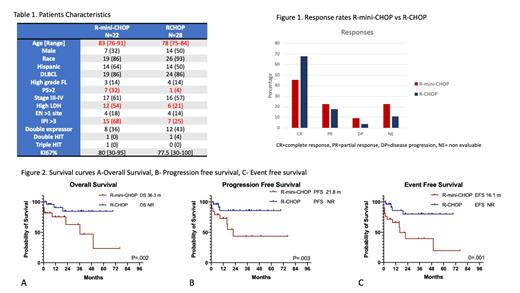Abstract
Introduction: DLBCL represents the most common lymphoma of the elderly, with R-CHOP remaining the standard of care. For elderly patients survival and outcomes data remains limited. Reduced dose R-mini-CHOP was demonstrated to be safe and effective treatment for elderly patients with overall survival of 58%. Defining predictor factors of response and identifying patients that benefit from R-CHOP remains essential.
Methods: Retrospective analysis of elderly patients (pts) with frontline DLBCL and high-grade FL treated with R-mini-CHOP and R-CHOP between April 2014 and June 2021. Adult pts 75 years and older were included in the analysis. We performed a chart review to obtain treatment responses and analyze correlations between clinical, molecular characteristics and outcomes. A comparative study with outcomes of standard R-CHOP treatment was conducted. Primary objective was to determine safety and efficacy of R-mini-CHOP in elderly pts. Secondary objectives include overall response rates (ORR), overall survival (OS), and progression-free survival (PFS) after R-mini-CHOP compared with standard R-CHOP.
Results: A total of 22 frontline elderly pts 75 years and older were included. Twenty pts (91%) were >80 years, with a median age of 83 years. Most patients had a diagnosis of DLBCL (86%), with stage III-IV in 61%. LDH was increased in 54% of pts. Fifteen pts had a high-risk IPI score (68%). Baseline characteristics are listed in Table 1.
Sixteen pts (73%) completed at least 3 cycles of therapy, with a median of 4 cycles (range 1-6). Nineteen pts were evaluable for response. With a median follow-up of 16 months, the overall response rate (ORR) was 79%, including 53% complete response and 26% partial response. Figure 1.
The overall survival (OS) was 36 months with a progression-free survival of 22 months and event-free survival of 16 months. With a 2-year OS and PFS of 63% and 44%, respectably, with a median duration of response of 44 months. A total of 7 pts died (32%), 3 pts from disease progression (14%), 3 pts from infection (14%), and 1 pt from bleeding (4%); and the 4-week mortality rate was 18%.
Response rates were compared with a contemporary group treated with standard R-CHOP therapy. Significant differences were observed between both subgroups with an increased performance status (PS>2) (P=<0.001), LDH (P=0.015), and high-risk IPI score (P=0.002) among R-mini-CHOP pts compared to R-CHOP pts. With a significantly younger median age of 78 years for R-CHOP vs 83 years for R-mini-CHOP pts (P=<0.001). Table 1. Univariate analysis for predictors of response revealed a PS equal to 2 or higher to be significantly associated with decreased response rates. (Odds ratio 0.1, P=0.007)
Among R-CHOP treated pts, the ORR was 96% with 76% complete responses, while the OS, PFS, and EFS were not reached. Figure 2.
Conclusions: Dose-reduced R-mini-CHOP is an effective and safe therapy for elderly patients with a diagnosis of DLBCL and high-grade FL. Response rates compared favorably with previously reported 2-year OS 58% and PFS 47% by the GELA study. Compared with contemporary subgroup treated with R-CHOP therapy showed higher response rates with significantly improved OS and PFS. However, pts in this group were younger with a significantly lower IPI and PS. Further comparison analysis with historical R-CHOP and R-CVP therapy is undergoing
No relevant conflicts of interest to declare.


